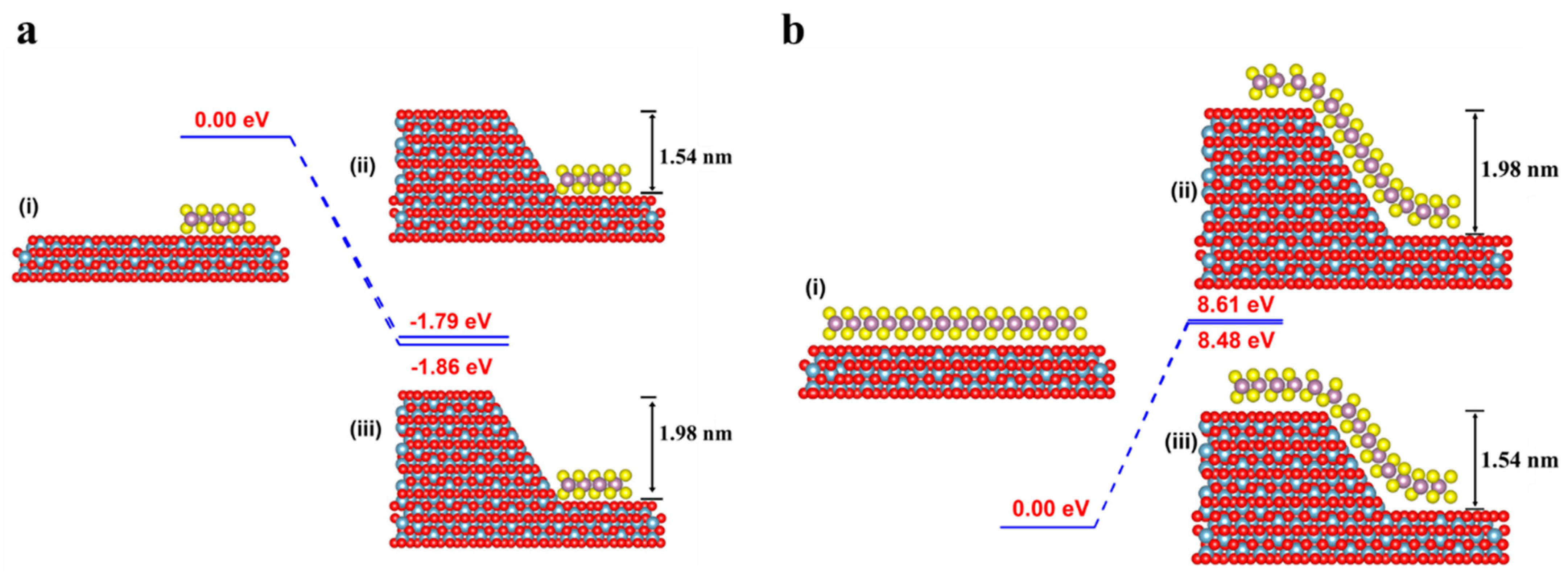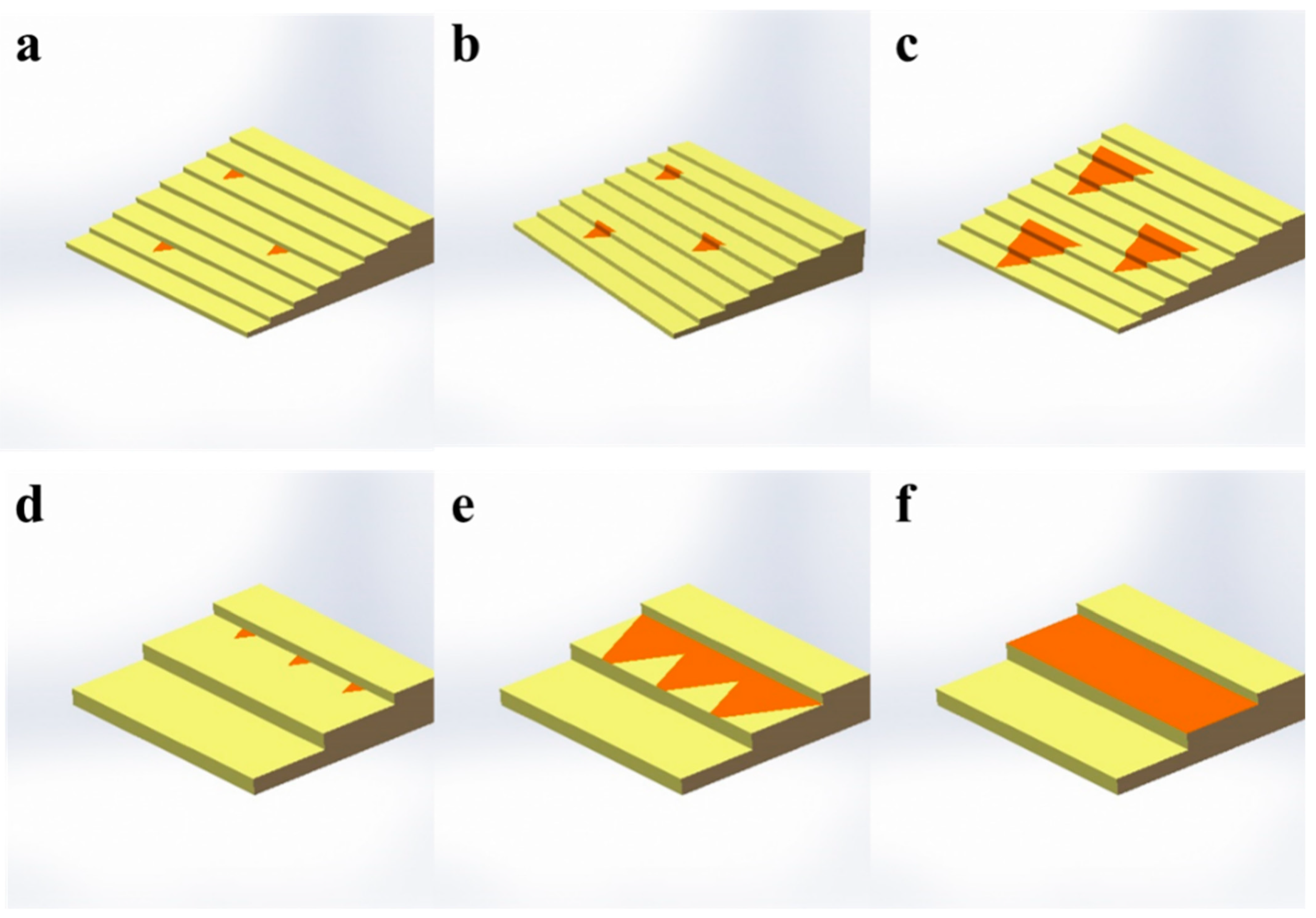Impact of Sapphire Step Height on the Growth of Monolayer Molybdenum Disulfide
Abstract
:1. Introduction
2. Materials and Methods
2.1. Annealing of Sapphire
2.2. Synthesis of MoS2
2.3. Sample Characterizations
2.4. CP2K Calculation
3. Results and Discussion
4. Conclusions
Supplementary Materials
Author Contributions
Funding
Institutional Review Board Statement
Informed Consent Statement
Data Availability Statement
Conflicts of Interest
References
- Li, W.S.; Gong, X.S.; Yu, Z.H.; Ma, L.; Sun, W.J.; Gao, S.; Köroglu, Ç.; Wang, W.F.; Liu, L.; Li, T.T.; et al. Approaching the Quantum Limit in Two-Dimensional Semiconductor Contacts. Nature 2023, 613, 274–279. [Google Scholar] [CrossRef] [PubMed]
- Feng, S.; Liu, C.; Zhu, Q.B.; Su, X.; Qian, W.W.; Sun, Y.; Wang, C.X.; Li, B.; Chen, M.L.; Chen, L.; et al. An Ultrasensitive Molybdenum-Based Double-Heterojunction Phototransistor. Nat. Commun. 2021, 12, 4094. [Google Scholar] [CrossRef] [PubMed]
- Sun, Y.X.; Jiang, L.Y.; Wang, Z.; Hou, Z.F.; Dai, L.Y.; Wang, Y.K.; Zhao, J.Y.; Xie, Y.H.; Zhao, L.B.; Jiang, Z.D.; et al. Multiwavelength High-Detectivity MoS2 Photodetectors with Schottky Contacts. ACS Nano 2022, 16, 20272–20280. [Google Scholar] [CrossRef] [PubMed]
- Wang, Z.; Kang, Y.; Hu, J.; Ji, Q.; Lu, Z.; Xu, G.; Qi, Y.; Zhang, M.; Zhang, W.; Huang, R.; et al. Boosting CO2 Hydrogenation to Formate over Edge-Sulfur Vacancies of Molybdenum Disulfide. Angew. Chem. Int. Ed. 2023, 62, e202307086. [Google Scholar] [CrossRef] [PubMed]
- Sangiovanni, D.G.; Faccio, R.; Gueorguiev, G.K.; Kakanakova-Georgieva, A. Discovering Atomistic Pathways for Supply of Metal Atoms from Methyl-Based Precursors to Graphene Surface. Phys. Chem. Chem. Phys. 2023, 25, 829–837. [Google Scholar] [CrossRef] [PubMed]
- Kakanakova-Georgieva, A.; Ivanov, I.G.; Suwannaharn, N.; Hsu, C.W.; Cora, I.; Pécz, B.; Giannazzo, F.; Sangiovanni, D.G.; Gueorguiev, G.K. Mocvd of Aln on Epitaxial Graphene at Extreme Temperatures. Crystengcomm 2021, 23, 385–390. [Google Scholar] [CrossRef]
- Al Balushi, Z.Y.; Wang, K.; Ghosh, R.K.; Vilá, R.A.; Eichfeld, S.M.; Caldwell, J.D.; Qin, X.Y.; Lin, Y.C.; DeSario, P.A.; Stone, G.; et al. Two-Dimensional Gallium Nitride Realized Via Graphene Encapsulation. Nat. Mater. 2016, 15, 1166–1171. [Google Scholar] [CrossRef]
- Yang, P.F.; Zou, X.L.; Zhang, Z.P.; Hong, M.; Shi, J.P.; Chen, S.L.; Shu, J.P.; Zhao, L.Y.; Jiang, S.L.; Zhou, X.B.; et al. Batch Production of 6-Inch Uniform Monolayer Molybdenum Disulfide Catalyzed by Sodium in Glass. Nat. Commun. 2018, 9, 979. [Google Scholar] [CrossRef]
- Zhou, J.D.; Lin, J.H.; Huang, X.W.; Zhou, Y.; Chen, Y.; Xia, J.; Wang, H.; Xie, Y.; Yu, H.M.; Lei, J.C.; et al. A Library of Atomically Thin Metal Chalcogenides. Nature 2018, 556, 355–359. [Google Scholar] [CrossRef]
- Yu, H.; Liao, M.; Zhao, W.; Liu, G.; Zhou, X.J.; Wei, Z.; Xu, X.; Liu, K.; Hu, Z.; Deng, K.; et al. Wafer-Scale Growth and Transfer of Highly-Oriented Monolayer MoS2 Continuous Films. ACS Nano 2017, 11, 12001–12007. [Google Scholar] [CrossRef]
- Zhang, K.A.; She, Y.H.; Cai, X.B.; Zhao, M.; Liu, Z.J.; Ding, C.C.; Zhang, L.J.; Zhou, W.; Ma, J.H.; Liu, H.W.; et al. Epitaxial Substitution of Metal Iodides for Low-Temperature Growth of Two-Dimensional Metal Chalcogenides. Nat. Nanotechnol. 2023, 18, 448–455. [Google Scholar] [CrossRef] [PubMed]
- Yang, P.; Zhang, S.; Pan, S.; Tang, B.; Liang, Y.; Zhao, X.; Zhang, Z.; Shi, J.; Huan, Y.; Shi, Y.; et al. Epitaxial Growth of Centimeter-Scale Single-Crystal MoS2 Monolayer on Au(111). ACS Nano 2020, 14, 5036–5045. [Google Scholar] [CrossRef] [PubMed]
- Li, T.T.; Guo, W.; Ma, L.; Li, W.S.; Yu, Z.H.; Han, Z.; Gao, S.; Liu, L.; Fan, D.X.; Wang, Z.X.; et al. Epitaxial Growth of Wafer-Scale Molybdenum Disulfide Semiconductor Single Crystals on Sapphire. Nat. Nanotechnol. 2021, 16, 1201–1207. [Google Scholar] [CrossRef]
- Wang, J.; Xu, X.; Cheng, T.; Gu, L.; Qiao, R.; Liang, Z.; Ding, D.; Hong, H.; Zheng, P.; Zhang, Z.; et al. Dual-Coupling-Guided Epitaxial Growth of Wafer-Scale Single-Crystal WS2 Monolayer on Vicinal a-Plane Sapphire. Nat. Nanotechnol. 2021, 17, 33–38. [Google Scholar] [CrossRef] [PubMed]
- Zheng, P.M.; Wei, W.Y.; Liang, Z.H.; Qin, B.; Tian, J.P.; Wang, J.H.; Qiao, R.X.; Ren, Y.L.; Chen, J.T.; Huang, C.; et al. Universal Epitaxy of Non-Centrosymmetric Two-Dimensional Single-Crystal Metal Dichalcogenides. Nat. Commun. 2023, 14, 592. [Google Scholar] [CrossRef]
- Liu, L.; Li, T.T.; Ma, L.; Li, W.S.; Gao, S.; Sun, W.J.; Dong, R.K.; Zou, X.L.; Fan, D.X.; Shao, L.W.; et al. Uniform Nucleation and Epitaxy of Bilayer Molybdenum Disulfide on Sapphire. Nature 2022, 605, 69–75. [Google Scholar] [CrossRef]
- Dong, R.K.; Gong, X.S.; Yang, J.F.; Sun, Y.M.; Ma, L.; Wang, J.L. The Intrinsic Thermodynamic Difficulty and a Step-Guided Mechanism for the Epitaxial Growth of Uniform Multilayer MoS2 with Controllable Thickness. Adv. Mater. 2022, 34, e2201402. [Google Scholar] [CrossRef]
- Kühne, T.D.; Iannuzzi, M.; Del Ben, M.; Rybkin, V.V.; Seewald, P.; Stein, F.; Laino, T.; Khaliullin, R.Z.; Schütt, O.; Schiffmann, F.; et al. CP2K: An Electronic Structure and Molecular Dynamics Software Package—Quickstep: Efficient and Accurate Electronic Structure Calculations. J. Chem. Phys. 2020, 152, 194103. [Google Scholar] [CrossRef]
- VandeVondele, J.; Krack, M.; Mohamed, F.; Parrinello, M.; Chassaing, T.; Hutter, J. Quickstep: Fast and Accurate Density Functional Calculations Using a Mixed Gaussian and Plane Waves Approach. Comput. Phys. Commun. 2005, 167, 103–128. [Google Scholar] [CrossRef]
- VandeVondele, J.; Hutter, J. Gaussian Basis Sets for Accurate Calculations on Molecular Systems in Gas and Condensed Phases. J. Chem. Phys. 2007, 127, 114105. [Google Scholar] [CrossRef]
- Krack, M. Pseudopotentials for H to Kr Optimized for Gradient-Corrected Exchange-Correlation Functionals. Theor. Chem. Acc. 2005, 114, 145–152. [Google Scholar] [CrossRef]
- Hartwigsen, C.; Goedecker, S.; Hutter, J. Relativistic Separable Dual-Space Gaussian Pseudopotentials from H to Rn. Phys. Rev. B 1998, 58, 3641–3662. [Google Scholar] [CrossRef]
- Perdew, J.P.; Burke, K.; Ernzerhof, M. Generalized Gradient Approximation Made Simple. Phys. Rev. Lett. 1996, 77, 3865–3868. [Google Scholar] [CrossRef] [PubMed]
- Grimme, S.; Ehrlich, S.; Goerigk, L. Effect of the Damping Function in Dispersion Corrected Density Functional Theory. J. Comput. Chem. 2011, 32, 1456–1465. [Google Scholar] [CrossRef] [PubMed]
- Lu, T.; Chen, F.W. Multiwfn: A Multifunctional Wavefunction Analyzer. J. Comput. Chem. 2012, 33, 580–592. [Google Scholar] [CrossRef] [PubMed]
- Ji, H.G.; Lin, Y.C.; Nagashio, K.; Maruyama, M.; Solís-Fernández, P.; Aji, A.S.; Panchal, V.; Okada, S.; Suenaga, K.; Ago, H. Hydrogen-Assisted Epitaxial Growth of Monolayer Tungsten Disulfide and Seamless Grain Stitching. Chem. Mater. 2018, 30, 403–411. [Google Scholar] [CrossRef]
- Ago, H.; Fukamachi, S.; Endo, H.; Solís-Fernández, P.; Yunus, R.M.; Uchida, Y.; Panchal, V.; Kazakova, O.; Tsuji, M. Visualization of Grain Structure and Boundaries of Polycrystalline Graphene and Two-Dimensional Materials by Epitaxial Growth of Transition Metal Dichalcogenides. ACS Nano 2016, 10, 3233–3240. [Google Scholar] [CrossRef]
- Wang, Q.Q.; Li, N.; Tang, J.; Zhu, J.Q.; Zhang, Q.H.; Jia, Q.; Lu, Y.; Wei, Z.; Yu, H.; Zhao, Y.C.; et al. Wafer-Scale Highly Oriented Monolayer Mos2 with Large Domain Sizes. Nano Lett. 2020, 20, 7193–7199. [Google Scholar] [CrossRef]





Disclaimer/Publisher’s Note: The statements, opinions and data contained in all publications are solely those of the individual author(s) and contributor(s) and not of MDPI and/or the editor(s). MDPI and/or the editor(s) disclaim responsibility for any injury to people or property resulting from any ideas, methods, instructions or products referred to in the content. |
© 2023 by the authors. Licensee MDPI, Basel, Switzerland. This article is an open access article distributed under the terms and conditions of the Creative Commons Attribution (CC BY) license (https://creativecommons.org/licenses/by/4.0/).
Share and Cite
Lu, J.; Zheng, M.; Liu, J.; Zhang, Y.; Zhang, X.; Cai, W. Impact of Sapphire Step Height on the Growth of Monolayer Molybdenum Disulfide. Nanomaterials 2023, 13, 3056. https://doi.org/10.3390/nano13233056
Lu J, Zheng M, Liu J, Zhang Y, Zhang X, Cai W. Impact of Sapphire Step Height on the Growth of Monolayer Molybdenum Disulfide. Nanomaterials. 2023; 13(23):3056. https://doi.org/10.3390/nano13233056
Chicago/Turabian StyleLu, Jie, Miaomiao Zheng, Jinxin Liu, Yufeng Zhang, Xueao Zhang, and Weiwei Cai. 2023. "Impact of Sapphire Step Height on the Growth of Monolayer Molybdenum Disulfide" Nanomaterials 13, no. 23: 3056. https://doi.org/10.3390/nano13233056
APA StyleLu, J., Zheng, M., Liu, J., Zhang, Y., Zhang, X., & Cai, W. (2023). Impact of Sapphire Step Height on the Growth of Monolayer Molybdenum Disulfide. Nanomaterials, 13(23), 3056. https://doi.org/10.3390/nano13233056






